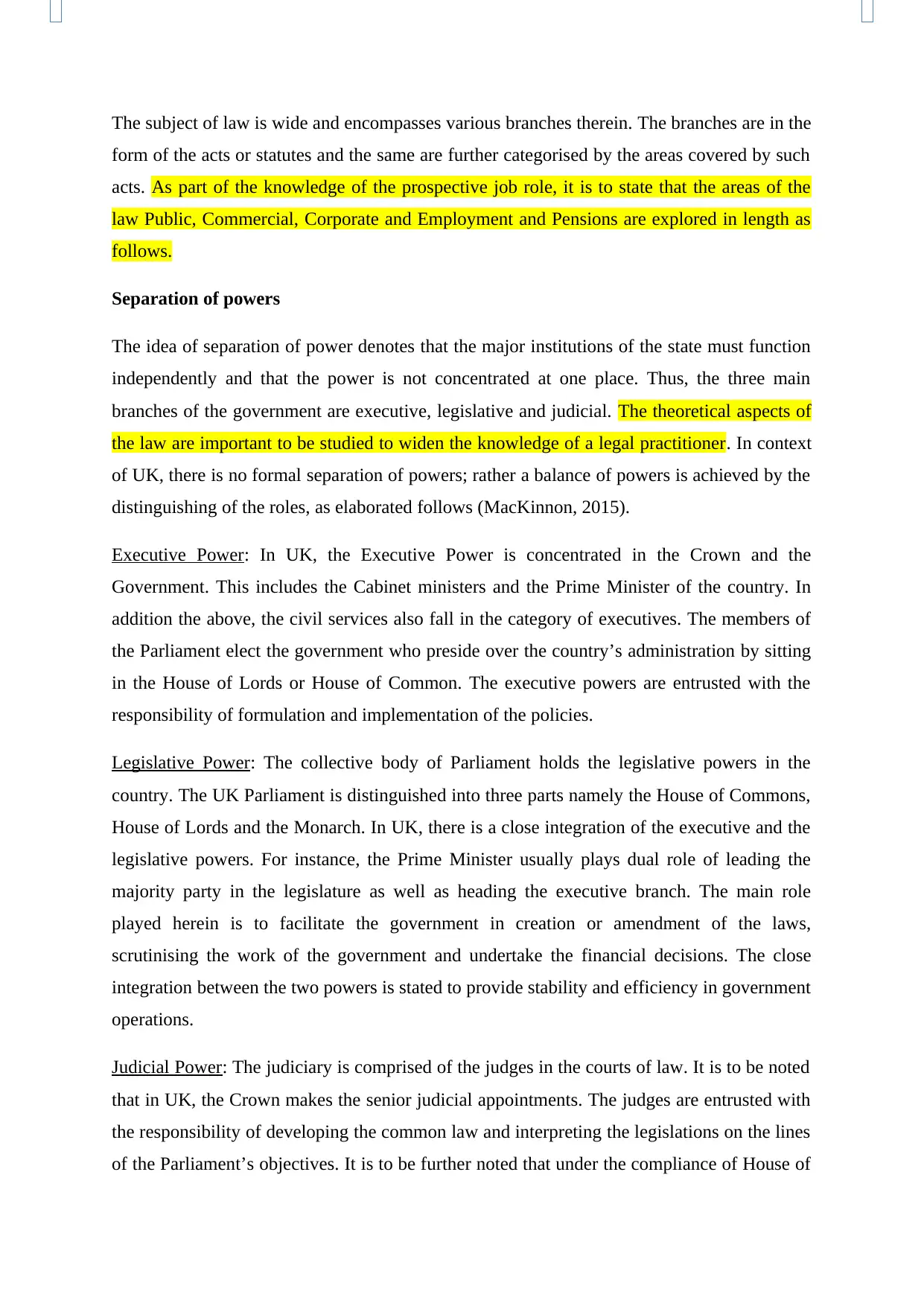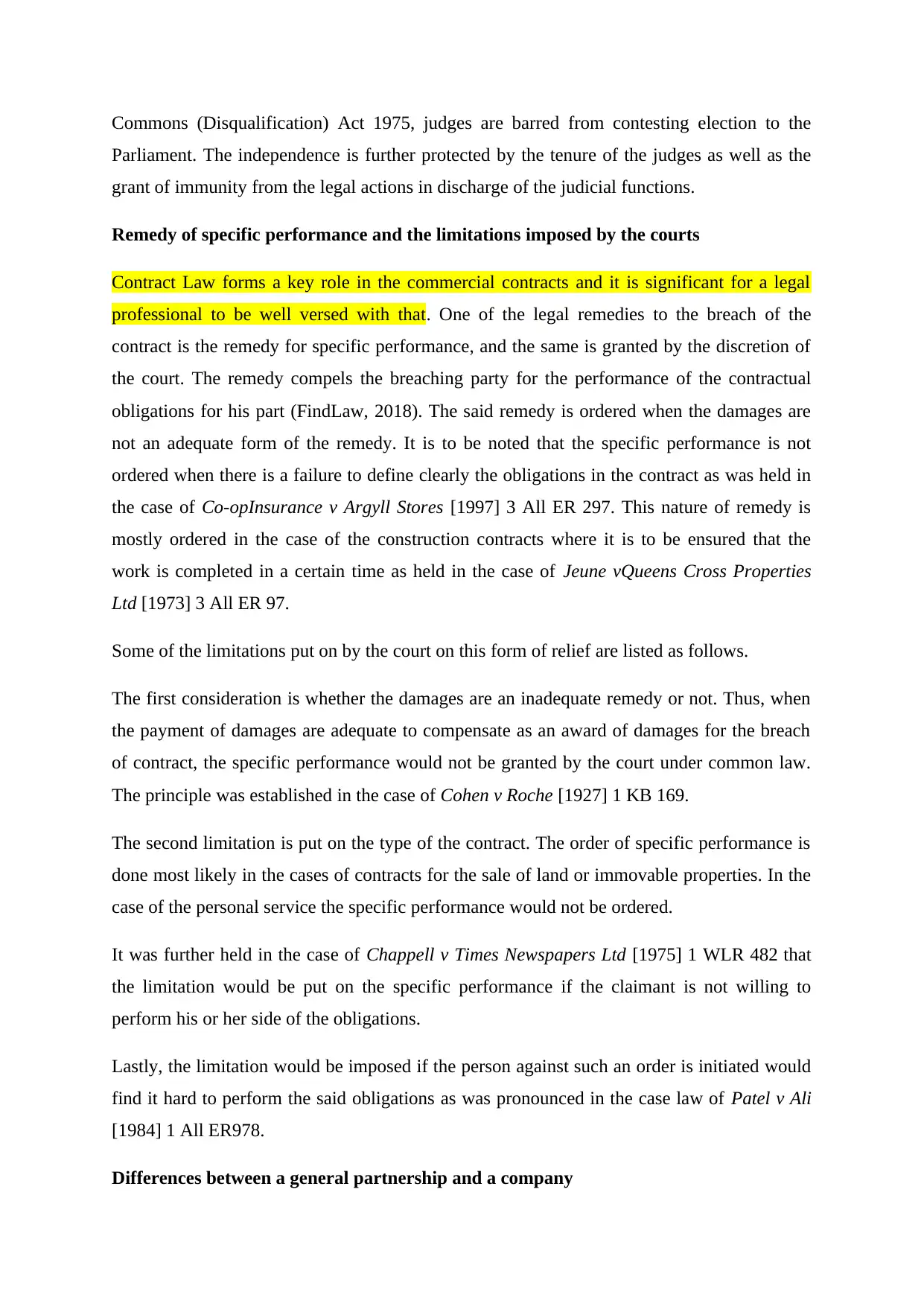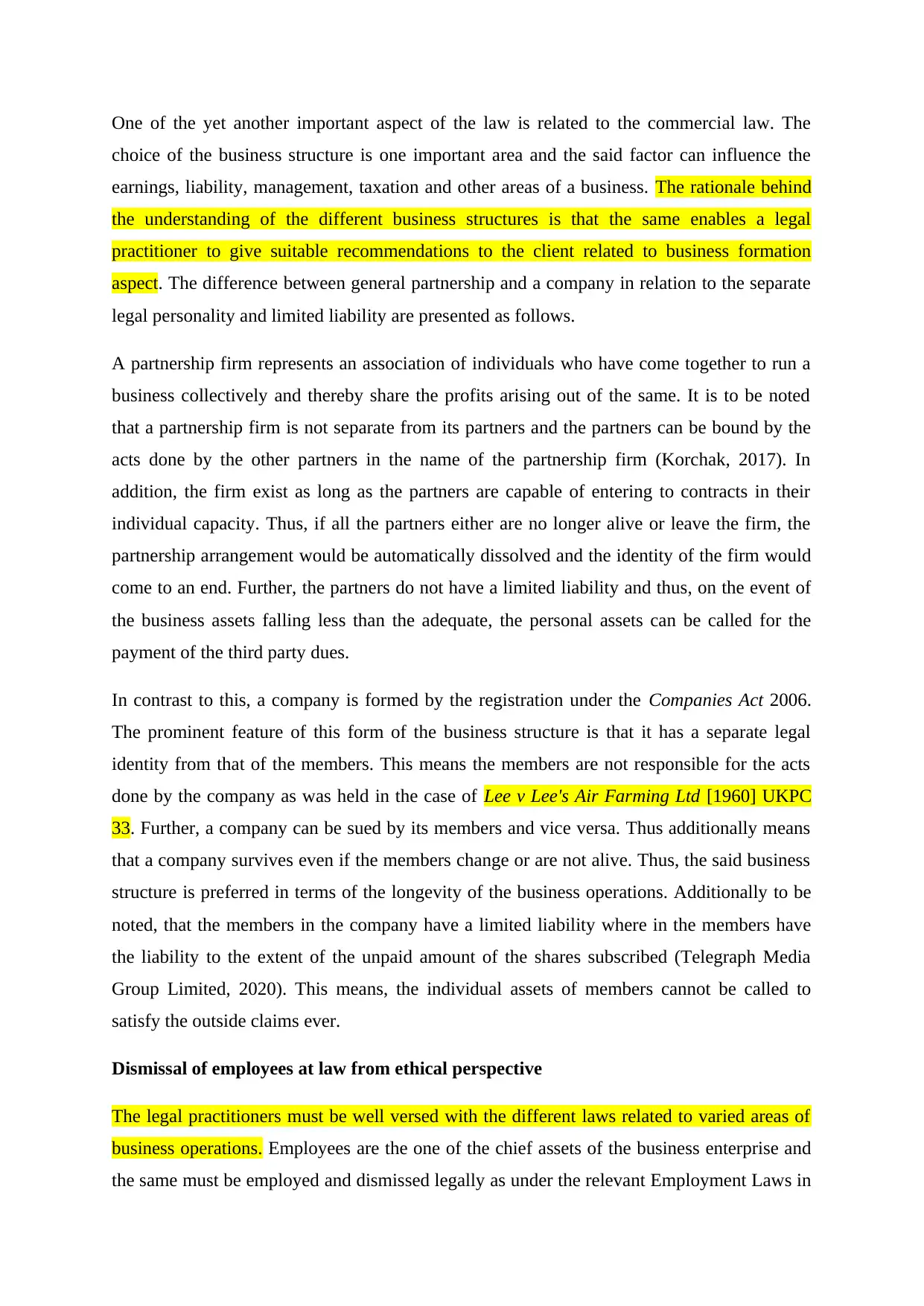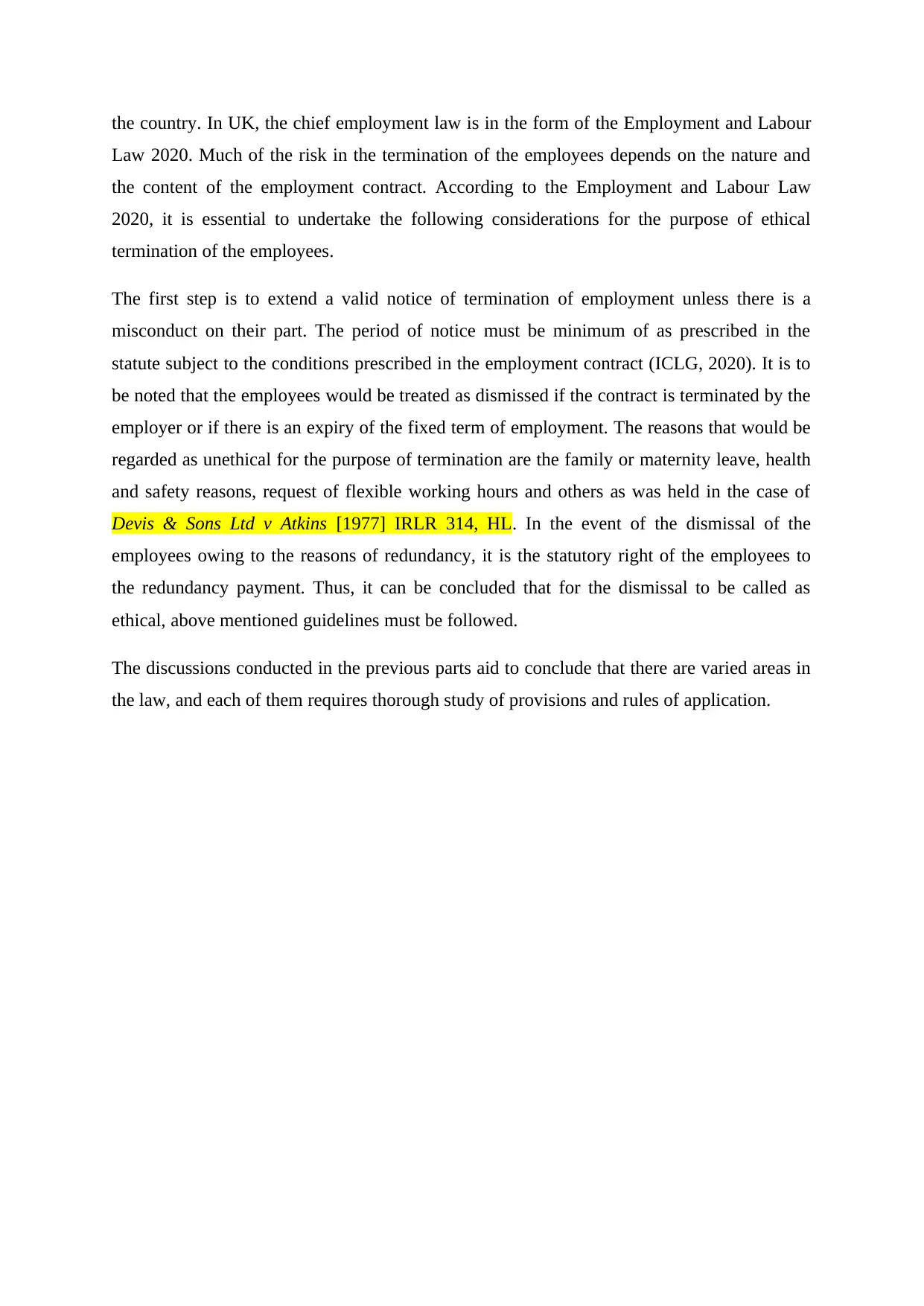Assignment about Law and Ethics
VerifiedAdded on 2022/09/14
|6
|1986
|13
Assignment
AI Summary
individual easy please use , UK language in writing . and easy structures like as : title at the beginning , introduction main boady ,summarise conclusion etc
Contribute Materials
Your contribution can guide someone’s learning journey. Share your
documents today.

Law and Ethics
Secure Best Marks with AI Grader
Need help grading? Try our AI Grader for instant feedback on your assignments.

The subject of law is wide and encompasses various branches therein. The branches are in the
form of the acts or statutes and the same are further categorised by the areas covered by such
acts. As part of the knowledge of the prospective job role, it is to state that the areas of the
law Public, Commercial, Corporate and Employment and Pensions are explored in length as
follows.
Separation of powers
The idea of separation of power denotes that the major institutions of the state must function
independently and that the power is not concentrated at one place. Thus, the three main
branches of the government are executive, legislative and judicial. The theoretical aspects of
the law are important to be studied to widen the knowledge of a legal practitioner. In context
of UK, there is no formal separation of powers; rather a balance of powers is achieved by the
distinguishing of the roles, as elaborated follows (MacKinnon, 2015).
Executive Power: In UK, the Executive Power is concentrated in the Crown and the
Government. This includes the Cabinet ministers and the Prime Minister of the country. In
addition the above, the civil services also fall in the category of executives. The members of
the Parliament elect the government who preside over the country’s administration by sitting
in the House of Lords or House of Common. The executive powers are entrusted with the
responsibility of formulation and implementation of the policies.
Legislative Power: The collective body of Parliament holds the legislative powers in the
country. The UK Parliament is distinguished into three parts namely the House of Commons,
House of Lords and the Monarch. In UK, there is a close integration of the executive and the
legislative powers. For instance, the Prime Minister usually plays dual role of leading the
majority party in the legislature as well as heading the executive branch. The main role
played herein is to facilitate the government in creation or amendment of the laws,
scrutinising the work of the government and undertake the financial decisions. The close
integration between the two powers is stated to provide stability and efficiency in government
operations.
Judicial Power: The judiciary is comprised of the judges in the courts of law. It is to be noted
that in UK, the Crown makes the senior judicial appointments. The judges are entrusted with
the responsibility of developing the common law and interpreting the legislations on the lines
of the Parliament’s objectives. It is to be further noted that under the compliance of House of
form of the acts or statutes and the same are further categorised by the areas covered by such
acts. As part of the knowledge of the prospective job role, it is to state that the areas of the
law Public, Commercial, Corporate and Employment and Pensions are explored in length as
follows.
Separation of powers
The idea of separation of power denotes that the major institutions of the state must function
independently and that the power is not concentrated at one place. Thus, the three main
branches of the government are executive, legislative and judicial. The theoretical aspects of
the law are important to be studied to widen the knowledge of a legal practitioner. In context
of UK, there is no formal separation of powers; rather a balance of powers is achieved by the
distinguishing of the roles, as elaborated follows (MacKinnon, 2015).
Executive Power: In UK, the Executive Power is concentrated in the Crown and the
Government. This includes the Cabinet ministers and the Prime Minister of the country. In
addition the above, the civil services also fall in the category of executives. The members of
the Parliament elect the government who preside over the country’s administration by sitting
in the House of Lords or House of Common. The executive powers are entrusted with the
responsibility of formulation and implementation of the policies.
Legislative Power: The collective body of Parliament holds the legislative powers in the
country. The UK Parliament is distinguished into three parts namely the House of Commons,
House of Lords and the Monarch. In UK, there is a close integration of the executive and the
legislative powers. For instance, the Prime Minister usually plays dual role of leading the
majority party in the legislature as well as heading the executive branch. The main role
played herein is to facilitate the government in creation or amendment of the laws,
scrutinising the work of the government and undertake the financial decisions. The close
integration between the two powers is stated to provide stability and efficiency in government
operations.
Judicial Power: The judiciary is comprised of the judges in the courts of law. It is to be noted
that in UK, the Crown makes the senior judicial appointments. The judges are entrusted with
the responsibility of developing the common law and interpreting the legislations on the lines
of the Parliament’s objectives. It is to be further noted that under the compliance of House of

Commons (Disqualification) Act 1975, judges are barred from contesting election to the
Parliament. The independence is further protected by the tenure of the judges as well as the
grant of immunity from the legal actions in discharge of the judicial functions.
Remedy of specific performance and the limitations imposed by the courts
Contract Law forms a key role in the commercial contracts and it is significant for a legal
professional to be well versed with that. One of the legal remedies to the breach of the
contract is the remedy for specific performance, and the same is granted by the discretion of
the court. The remedy compels the breaching party for the performance of the contractual
obligations for his part (FindLaw, 2018). The said remedy is ordered when the damages are
not an adequate form of the remedy. It is to be noted that the specific performance is not
ordered when there is a failure to define clearly the obligations in the contract as was held in
the case of Co-opInsurance v Argyll Stores [1997] 3 All ER 297. This nature of remedy is
mostly ordered in the case of the construction contracts where it is to be ensured that the
work is completed in a certain time as held in the case of Jeune vQueens Cross Properties
Ltd [1973] 3 All ER 97.
Some of the limitations put on by the court on this form of relief are listed as follows.
The first consideration is whether the damages are an inadequate remedy or not. Thus, when
the payment of damages are adequate to compensate as an award of damages for the breach
of contract, the specific performance would not be granted by the court under common law.
The principle was established in the case of Cohen v Roche [1927] 1 KB 169.
The second limitation is put on the type of the contract. The order of specific performance is
done most likely in the cases of contracts for the sale of land or immovable properties. In the
case of the personal service the specific performance would not be ordered.
It was further held in the case of Chappell v Times Newspapers Ltd [1975] 1 WLR 482 that
the limitation would be put on the specific performance if the claimant is not willing to
perform his or her side of the obligations.
Lastly, the limitation would be imposed if the person against such an order is initiated would
find it hard to perform the said obligations as was pronounced in the case law of Patel v Ali
[1984] 1 All ER978.
Differences between a general partnership and a company
Parliament. The independence is further protected by the tenure of the judges as well as the
grant of immunity from the legal actions in discharge of the judicial functions.
Remedy of specific performance and the limitations imposed by the courts
Contract Law forms a key role in the commercial contracts and it is significant for a legal
professional to be well versed with that. One of the legal remedies to the breach of the
contract is the remedy for specific performance, and the same is granted by the discretion of
the court. The remedy compels the breaching party for the performance of the contractual
obligations for his part (FindLaw, 2018). The said remedy is ordered when the damages are
not an adequate form of the remedy. It is to be noted that the specific performance is not
ordered when there is a failure to define clearly the obligations in the contract as was held in
the case of Co-opInsurance v Argyll Stores [1997] 3 All ER 297. This nature of remedy is
mostly ordered in the case of the construction contracts where it is to be ensured that the
work is completed in a certain time as held in the case of Jeune vQueens Cross Properties
Ltd [1973] 3 All ER 97.
Some of the limitations put on by the court on this form of relief are listed as follows.
The first consideration is whether the damages are an inadequate remedy or not. Thus, when
the payment of damages are adequate to compensate as an award of damages for the breach
of contract, the specific performance would not be granted by the court under common law.
The principle was established in the case of Cohen v Roche [1927] 1 KB 169.
The second limitation is put on the type of the contract. The order of specific performance is
done most likely in the cases of contracts for the sale of land or immovable properties. In the
case of the personal service the specific performance would not be ordered.
It was further held in the case of Chappell v Times Newspapers Ltd [1975] 1 WLR 482 that
the limitation would be put on the specific performance if the claimant is not willing to
perform his or her side of the obligations.
Lastly, the limitation would be imposed if the person against such an order is initiated would
find it hard to perform the said obligations as was pronounced in the case law of Patel v Ali
[1984] 1 All ER978.
Differences between a general partnership and a company

One of the yet another important aspect of the law is related to the commercial law. The
choice of the business structure is one important area and the said factor can influence the
earnings, liability, management, taxation and other areas of a business. The rationale behind
the understanding of the different business structures is that the same enables a legal
practitioner to give suitable recommendations to the client related to business formation
aspect. The difference between general partnership and a company in relation to the separate
legal personality and limited liability are presented as follows.
A partnership firm represents an association of individuals who have come together to run a
business collectively and thereby share the profits arising out of the same. It is to be noted
that a partnership firm is not separate from its partners and the partners can be bound by the
acts done by the other partners in the name of the partnership firm (Korchak, 2017). In
addition, the firm exist as long as the partners are capable of entering to contracts in their
individual capacity. Thus, if all the partners either are no longer alive or leave the firm, the
partnership arrangement would be automatically dissolved and the identity of the firm would
come to an end. Further, the partners do not have a limited liability and thus, on the event of
the business assets falling less than the adequate, the personal assets can be called for the
payment of the third party dues.
In contrast to this, a company is formed by the registration under the Companies Act 2006.
The prominent feature of this form of the business structure is that it has a separate legal
identity from that of the members. This means the members are not responsible for the acts
done by the company as was held in the case of Lee v Lee's Air Farming Ltd [1960] UKPC
33. Further, a company can be sued by its members and vice versa. Thus additionally means
that a company survives even if the members change or are not alive. Thus, the said business
structure is preferred in terms of the longevity of the business operations. Additionally to be
noted, that the members in the company have a limited liability where in the members have
the liability to the extent of the unpaid amount of the shares subscribed (Telegraph Media
Group Limited, 2020). This means, the individual assets of members cannot be called to
satisfy the outside claims ever.
Dismissal of employees at law from ethical perspective
The legal practitioners must be well versed with the different laws related to varied areas of
business operations. Employees are the one of the chief assets of the business enterprise and
the same must be employed and dismissed legally as under the relevant Employment Laws in
choice of the business structure is one important area and the said factor can influence the
earnings, liability, management, taxation and other areas of a business. The rationale behind
the understanding of the different business structures is that the same enables a legal
practitioner to give suitable recommendations to the client related to business formation
aspect. The difference between general partnership and a company in relation to the separate
legal personality and limited liability are presented as follows.
A partnership firm represents an association of individuals who have come together to run a
business collectively and thereby share the profits arising out of the same. It is to be noted
that a partnership firm is not separate from its partners and the partners can be bound by the
acts done by the other partners in the name of the partnership firm (Korchak, 2017). In
addition, the firm exist as long as the partners are capable of entering to contracts in their
individual capacity. Thus, if all the partners either are no longer alive or leave the firm, the
partnership arrangement would be automatically dissolved and the identity of the firm would
come to an end. Further, the partners do not have a limited liability and thus, on the event of
the business assets falling less than the adequate, the personal assets can be called for the
payment of the third party dues.
In contrast to this, a company is formed by the registration under the Companies Act 2006.
The prominent feature of this form of the business structure is that it has a separate legal
identity from that of the members. This means the members are not responsible for the acts
done by the company as was held in the case of Lee v Lee's Air Farming Ltd [1960] UKPC
33. Further, a company can be sued by its members and vice versa. Thus additionally means
that a company survives even if the members change or are not alive. Thus, the said business
structure is preferred in terms of the longevity of the business operations. Additionally to be
noted, that the members in the company have a limited liability where in the members have
the liability to the extent of the unpaid amount of the shares subscribed (Telegraph Media
Group Limited, 2020). This means, the individual assets of members cannot be called to
satisfy the outside claims ever.
Dismissal of employees at law from ethical perspective
The legal practitioners must be well versed with the different laws related to varied areas of
business operations. Employees are the one of the chief assets of the business enterprise and
the same must be employed and dismissed legally as under the relevant Employment Laws in
Secure Best Marks with AI Grader
Need help grading? Try our AI Grader for instant feedback on your assignments.

the country. In UK, the chief employment law is in the form of the Employment and Labour
Law 2020. Much of the risk in the termination of the employees depends on the nature and
the content of the employment contract. According to the Employment and Labour Law
2020, it is essential to undertake the following considerations for the purpose of ethical
termination of the employees.
The first step is to extend a valid notice of termination of employment unless there is a
misconduct on their part. The period of notice must be minimum of as prescribed in the
statute subject to the conditions prescribed in the employment contract (ICLG, 2020). It is to
be noted that the employees would be treated as dismissed if the contract is terminated by the
employer or if there is an expiry of the fixed term of employment. The reasons that would be
regarded as unethical for the purpose of termination are the family or maternity leave, health
and safety reasons, request of flexible working hours and others as was held in the case of
Devis & Sons Ltd v Atkins [1977] IRLR 314, HL. In the event of the dismissal of the
employees owing to the reasons of redundancy, it is the statutory right of the employees to
the redundancy payment. Thus, it can be concluded that for the dismissal to be called as
ethical, above mentioned guidelines must be followed.
The discussions conducted in the previous parts aid to conclude that there are varied areas in
the law, and each of them requires thorough study of provisions and rules of application.
Law 2020. Much of the risk in the termination of the employees depends on the nature and
the content of the employment contract. According to the Employment and Labour Law
2020, it is essential to undertake the following considerations for the purpose of ethical
termination of the employees.
The first step is to extend a valid notice of termination of employment unless there is a
misconduct on their part. The period of notice must be minimum of as prescribed in the
statute subject to the conditions prescribed in the employment contract (ICLG, 2020). It is to
be noted that the employees would be treated as dismissed if the contract is terminated by the
employer or if there is an expiry of the fixed term of employment. The reasons that would be
regarded as unethical for the purpose of termination are the family or maternity leave, health
and safety reasons, request of flexible working hours and others as was held in the case of
Devis & Sons Ltd v Atkins [1977] IRLR 314, HL. In the event of the dismissal of the
employees owing to the reasons of redundancy, it is the statutory right of the employees to
the redundancy payment. Thus, it can be concluded that for the dismissal to be called as
ethical, above mentioned guidelines must be followed.
The discussions conducted in the previous parts aid to conclude that there are varied areas in
the law, and each of them requires thorough study of provisions and rules of application.

References
Chappell v Times Newspapers Ltd [1975] 1 WLR 482
Cohen v Roche [1927] 1 KB 169
Co-opInsurance v Argyll Stores [1997] 3 All ER 297
Devis & Sons Ltd v Atkins [1977] IRLR 314, HL
FindLaw (2018) What Is 'Specific Performance' as a Legal Remedy? [online] Available from:
https://smallbusiness.findlaw.com/business-contracts-forms/what-is-specific-performance-as-
a-legal-remedy.html [Accessed on: 08 April 2020].
ICLG (2020) United Kingdom: Employment & Labour Law 2020 [online] Available from:
https://iclg.com/practice-areas/employment-and-labour-laws-and-regulations/united-kingdom
[Accessed on: 08 April 2020].
Jeune vQueens Cross Properties Ltd [1973] 3 All ER 97
Korchak, J. (2017) Advantages and disadvantages of a partnership business [online]
Available from: https://www.informdirect.co.uk/business-management/partnership-business-
advantages-and-disadvantages/ [Accessed on: 08 April 2020].
Lee v Lee's Air Farming Ltd [1960] UKPC 33
MacKinnon, D. (2015) Devolution, state restructuring and policy divergence in the UK. The
Geographical Journal, 181(1), pp. 47-56.
Patel v Ali [1984] 1 All ER978
Telegraph Media Group Limited (2020) Why setting up a limited company can pay dividends
[online] Available from:
https://www.telegraph.co.uk/business/becoming-self-employed/limited-company-benefits/
[Accessed on: 08 April 2020].
Chappell v Times Newspapers Ltd [1975] 1 WLR 482
Cohen v Roche [1927] 1 KB 169
Co-opInsurance v Argyll Stores [1997] 3 All ER 297
Devis & Sons Ltd v Atkins [1977] IRLR 314, HL
FindLaw (2018) What Is 'Specific Performance' as a Legal Remedy? [online] Available from:
https://smallbusiness.findlaw.com/business-contracts-forms/what-is-specific-performance-as-
a-legal-remedy.html [Accessed on: 08 April 2020].
ICLG (2020) United Kingdom: Employment & Labour Law 2020 [online] Available from:
https://iclg.com/practice-areas/employment-and-labour-laws-and-regulations/united-kingdom
[Accessed on: 08 April 2020].
Jeune vQueens Cross Properties Ltd [1973] 3 All ER 97
Korchak, J. (2017) Advantages and disadvantages of a partnership business [online]
Available from: https://www.informdirect.co.uk/business-management/partnership-business-
advantages-and-disadvantages/ [Accessed on: 08 April 2020].
Lee v Lee's Air Farming Ltd [1960] UKPC 33
MacKinnon, D. (2015) Devolution, state restructuring and policy divergence in the UK. The
Geographical Journal, 181(1), pp. 47-56.
Patel v Ali [1984] 1 All ER978
Telegraph Media Group Limited (2020) Why setting up a limited company can pay dividends
[online] Available from:
https://www.telegraph.co.uk/business/becoming-self-employed/limited-company-benefits/
[Accessed on: 08 April 2020].
1 out of 6
Related Documents
Your All-in-One AI-Powered Toolkit for Academic Success.
+13062052269
info@desklib.com
Available 24*7 on WhatsApp / Email
![[object Object]](/_next/static/media/star-bottom.7253800d.svg)
Unlock your academic potential
© 2024 | Zucol Services PVT LTD | All rights reserved.





